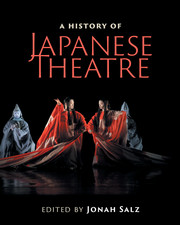Book contents
- Frontmatter
- Contents
- List of figures
- List of tables
- Contributors
- Contributors’ biographies
- Foreword
- Acknowledgments
- Note on Japanese terms
- List of abbreviations
- Timeline
- Editor's introduction
- I Traditional theatres
- Preface to Part I Japanese civilization arises
- II Modern theatres
- Preface to Part II
- III Arcs and patterns
- IV Theatre architecture
- Preface to Part IV Evolution of Japanese theatre architecture
- V Theatre criticism
- VI Intercultural influences
- Epilogue: Frozen words and mythology
- Further reading
- Index
Preface to Part I Japanese civilization arises
Published online by Cambridge University Press: 05 July 2016
- Frontmatter
- Contents
- List of figures
- List of tables
- Contributors
- Contributors’ biographies
- Foreword
- Acknowledgments
- Note on Japanese terms
- List of abbreviations
- Timeline
- Editor's introduction
- I Traditional theatres
- Preface to Part I Japanese civilization arises
- II Modern theatres
- Preface to Part II
- III Arcs and patterns
- IV Theatre architecture
- Preface to Part IV Evolution of Japanese theatre architecture
- V Theatre criticism
- VI Intercultural influences
- Epilogue: Frozen words and mythology
- Further reading
- Index
Summary
Japan's society and culture have been determined largely by its geographical location: a series of islands on the fringe of China, one of the most enduring civilizations of the world. Japan is just far enough away from China to make it safe from military invasion (most of the time) yet accessible for trade and religious/cultural exchange. This distance meant that civilization came later to Japan than to China's contiguous neighbors in East and Southeast Asia, but also that Japan was able to maintain cultural and political autonomy throughout its history (the only exception being the brief US occupation, 1946–53). Japan–China relations took the form of continuous and varied connections, ongoing debates about what aspects of continental civilization should be adopted by Japan, and, conversely, what was and should remain “Japanese.”
Hybrid beliefs and language
While Japan's native language (in the Ural-Altaic family) and religion are very different from China's, Chinese civilization was perceived as so powerful and useful that Japan absorbed it while developing its own hybrid language and religion. Shinto (神道, the way of the gods), a pantheistic animist religion, has thrived from prehistory until today. Japan evolved into an agricultural society and Shinto believers prayed to, gave offerings to, and entertained their gods to ensure good weather and bountiful harvests, beseeching them to exorcise evil spirits that caused illness, crop disease, and infestation.
Buddhism came to Japan in the sixth century from India via China and Korea, embraced by the elite for its moral teachings and guarantee of an afterlife. Initially Buddhism helped the fledgling Japanese state solidify its political power, working in tandem with institutions and the political culture of Confucianism. Buddhism and Shinto have coexisted until today, enjoying a primarily harmonious and symbiotic relationship – most Japanese participate in rituals of both religions. The shrines and temples not only nourished ritual performances by priests and miko shrine maidens, but also became safe refuges and tax havens for secular entertainers at festivals.
By the seventh century, an imperial family emerged in Japan, head of a relatively small aristocracy that supported the emperor, while competing to wield power behind the throne. The Chinese model of a grand, long-lasting imperial capital inspired the Japanese to establish two great capitals in the classical age, Nara (710–84) then Kyoto (also called Heian-kyō, Miyako, or Kyō, 794–1868).
- Type
- Chapter
- Information
- A History of Japanese Theatre , pp. 1 - 3Publisher: Cambridge University PressPrint publication year: 2016

